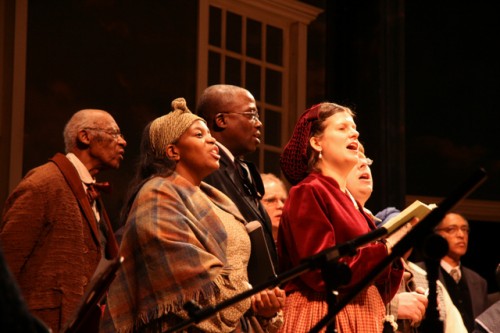This was originally posted August 5, 2013. I just spent all weekend singing with many of the same people I was singing with then, so I thought this – my first post as a person of LWON – was worth sharing again.

Recently I was rehearsing a glorious 16th-century motet with a group of 20 or so people. Haec dies quam fecit Dominus, the song begins. This is the day that the Lord has made; let us be glad and rejoice in it. It’s an Easter text and a lovely thought, whether or not you think the Lord actually made this day or whether the day made itself, thank you very much, from the rotation of the Earth. This is a day; let’s enjoy it.
The piece is by William Byrd, an English composer of Shakespeare’s time—yes, he’s wearing a ruff in his portrait—who wrote a lot of sacred music like this. The idea that different people could sing different things at the same time was fairly new in the Renaissance, and composers like Byrd went to town with it.
In Byrd’s six-part Haec Dies, the words and melody are split up and tossed back and forth between the vocal parts. I sing second soprano, the second highest. The first sopranos start the piece, then the altos join, then us. Sometimes we have the most prominent line; sometimes it’s another part. Women and tenors start the second section together: exultemus! Let’s exult! We settle into the alleluias, then sing a short duet with the basses, their low voices anchoring our rising line. Other parts pop out in turn. The lines come together and we converge and land, triumphant, on the final syllable of the final word. A perfectly tuned D-major chord fills the room. It feels as if everyone’s unified voice is flowing through my torso.
Last month, Swedish researchers published a study about heart rate in choirs. Fifteen 18-year-olds sat in a semicircle with heart-rate monitors clipped to their ears. The kids sang together, three different ways, each for five minutes. First they hummed a single tone, each breathing when needed. Then they sang a hymn. Last they sang a simple, slow tune that forced a breath after every 10-second phrase.
The singers’ heart rates went up and down as they breathed and sang. When they were just humming, their heart rates cycled at all different speeds. But when they were all breathing together in strict rhythm, the up-and-down lined up. In the hymn, breaths were less evenly spaced, so the picture was more complex, but the same thing happened; heart rates varied at the frequency of the breaths.
The researchers tie this to a known phenomenon: heart rate and breathing are linked. Your heartbeats vary all the time, depending on a lot of things, like loud sounds, exercise, and whether or not you’re being stalked by a lion. Breathe in and the heart speeds up; breathe out and it slows down.
When we’re singing the lively, complicated Byrd motet, things are surely even more complex than in the study’s sweet, unison hymn. Across the rehearsal room, in each section, hearts speed and slow together. The second sopranos breathe in and hearts beat faster; we breathe out on an alleluia and our hearts slow. We breathe in to end the phrase and our hearts speed up again, then slow while we wait for our next entrance. Last week we recorded the piece with a brass quintet who were breathing right along with us; it’ll be out this fall on a 30th anniversary CD for the Washington Revels.
Singing together is deeply satisfying. Whether it’s Byrd’s polyphony or “Take Me Out to the Ballgame,” you’re joining in common purpose with the people around you. Now we know part of why it feels so right: when we sing together, we’re lining up our hearts, too.
______
Image courtesy of Washington Revels.
I love the blend of art, emotion, science — and voices — in this post. It makes me extra glad to be singing next to you these day.